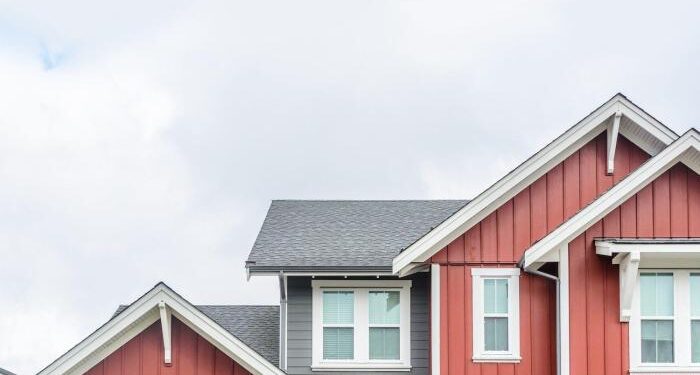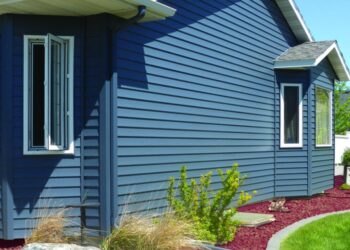Low cost siding options open up a world of possibilities for homeowners looking to enhance their property without breaking the bank. From durable vinyl siding to eco-friendly wood composite options, there are plenty of choices to suit every style and budget.
Dive into this guide to discover the best low-cost siding materials and how they can transform your home.
Low Cost Siding Options
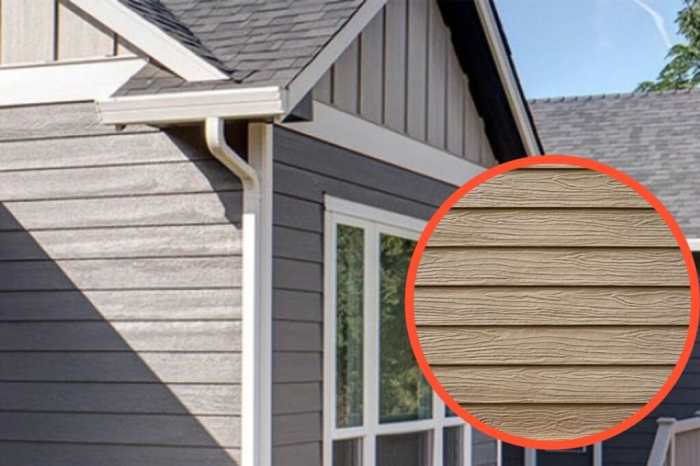
When it comes to low-cost siding options, homeowners have a variety of materials to choose from. Each option comes with its own set of advantages and considerations, including durability, maintenance requirements, aesthetic appeal, and impact on energy efficiency.
Vinyl Siding
Vinyl siding is a popular choice for those looking for a budget-friendly option. It is durable, requiring minimal maintenance such as occasional cleaning with a hose. Vinyl siding comes in a wide range of colors and styles, offering versatility in design.
While it may not be as energy-efficient as other options, proper insulation can help improve its performance.
Fiber Cement Siding
Fiber cement siding is known for its durability and low maintenance requirements. It can mimic the look of wood or stone siding at a fraction of the cost. Fiber cement siding is resistant to rot, fire, and pests, making it a long-lasting option.
Its insulating properties can also contribute to improved energy efficiency in homes.
Engineered Wood Siding
Engineered wood siding is a cost-effective alternative to real wood siding. It is easy to install and maintain, requiring periodic painting or staining to keep it looking fresh. Engineered wood siding offers the natural look of wood without the high price tag.
While it may not be as durable as other options, proper care can extend its lifespan.
Metal Siding
Metal siding, such as aluminum or steel, is a low-cost option that offers excellent durability and minimal maintenance. It is resistant to fire, rot, and pests, making it a long-lasting choice for homeowners. Metal siding can also contribute to improved energy efficiency by reflecting sunlight and reducing heat absorption into the home.
Conclusion
Each low-cost siding option has its own unique benefits and considerations. By understanding the durability, maintenance requirements, aesthetic appeal, and energy efficiency of different materials, homeowners can make an informed decision that meets their budget and preferences.
Vinyl Siding
Vinyl siding is a popular choice for homeowners looking for a low-cost and low-maintenance option to enhance the exterior of their homes. It is made from PVC (polyvinyl chloride) resin, making it durable, lightweight, and resistant to rot, mold, and insects.
Characteristics of Vinyl Siding
- Available in a wide range of colors and styles, including horizontal and vertical panels, shakes, shingles, and scallops.
- Easy to clean with just soap and water, reducing maintenance costs over time.
- Resistant to fading, cracking, and peeling, maintaining its appearance for years.
- Energy-efficient options with added insulation to improve the home's thermal performance.
Popular Vinyl Siding Styles
- Horizontal Panels: Mimic the look of traditional wood siding with a smooth or wood grain texture.
- Shakes and Shingles: Offer a rustic appearance with texture and depth for a unique look.
- Scallops: Add a touch of elegance with curved panels that create visual interest.
Installation Process for Vinyl Siding
Vinyl siding installation involves:
- Preparation of the exterior walls, including removing old siding and repairing any damage.
- Installation of insulation and a moisture barrier to improve energy efficiency and protect against water damage.
- Mounting of vinyl panels, starting from the bottom and working upwards to ensure proper alignment and overlap.
- Finishing touches, such as corner pieces, trim, and accessories to complete the look.
Cost Comparison of Vinyl Siding
When compared to other low-cost siding options like fiber cement or aluminum, vinyl siding typically falls in a similar price range per square foot
Despite this, vinyl siding remains a cost-effective choice for many homeowners seeking durability and aesthetic appeal without breaking the bank.
Fiber Cement Siding
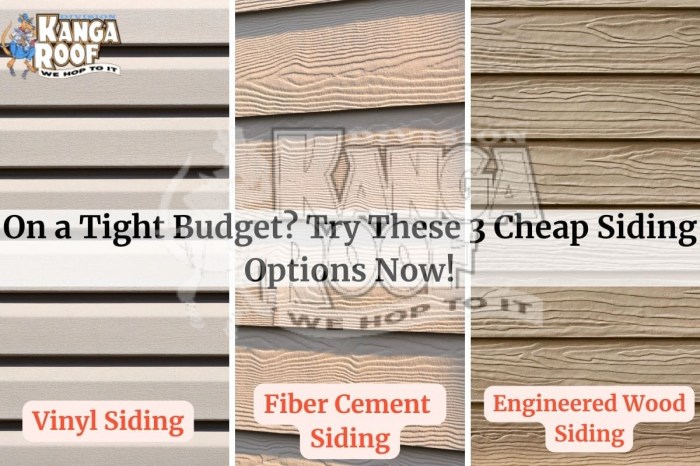
Fiber cement siding is a durable and low-maintenance exterior cladding material made from a mixture of cement, sand, and cellulose fibers. The combination of these materials gives fiber cement siding its strength and resistance to rot, fire, and insects.
Benefits of Fiber Cement Siding
- High durability: Fiber cement siding is resistant to rot, impact, fire, and insects, making it a long-lasting option for your home.
- Low maintenance: Unlike wood siding, fiber cement siding does not require frequent painting or staining, reducing overall maintenance costs.
- Versatility: Available in a variety of styles and colors, fiber cement siding can mimic the look of wood, stone, or stucco to suit different architectural designs.
- Weather-resistant: Fiber cement siding is able to withstand extreme weather conditions, including high winds and heavy rain, without warping or cracking.
Tips for Maintaining Fiber Cement Siding
- Regular cleaning: Periodically wash your fiber cement siding with a mild detergent and water to remove dirt and grime.
- Inspect for damage: Check for any cracks or chips in the siding and repair them promptly to prevent moisture infiltration.
- Repaint as needed: While fiber cement siding holds paint well, touch up any areas where the paint may be peeling or fading to maintain its appearance.
Cost-effectiveness of Fiber Cement Siding
Fiber cement siding is considered a cost-effective option in the long run due to its durability and low maintenance requirements. While the upfront cost may be higher compared to vinyl or wood siding, the overall lifespan and minimal upkeep needed make it a worthwhile investment for homeowners looking for a durable and attractive siding option.
Wood Composite Siding
Wood composite siding is a popular choice for homeowners looking for a durable and cost-effective alternative to traditional wood siding. It is made from a mixture of wood fibers, resin, and other materials, which are compressed and molded to create a strong and weather-resistant material.
Composition and Features
Wood composite siding combines the natural look and feel of wood with the low maintenance and durability of composite materials. It is resistant to rot, decay, and insects, making it a long-lasting option for your home. Additionally, it comes in a variety of styles and textures to suit different architectural designs.
Environmental Impact
Using wood composite siding can be a more environmentally friendly choice compared to other materials. The manufacturing process consumes less energy and produces fewer emissions, making it a sustainable option for eco-conscious homeowners.
Finishes Available
Wood composite siding is available in a range of finishes, including smooth, textured, and embossed surfaces. You can choose from a variety of colors and styles to match your home's aesthetic and create a unique look for your exterior.
Installation and Care Tips
Proper installation of wood composite siding is essential to ensure its longevity and performance. Make sure to follow manufacturer guidelines and use the correct tools and techniques. Regular maintenance such as cleaning and inspections can help prolong the lifespan of your siding and keep it looking great for years to come.
Ultimate Conclusion
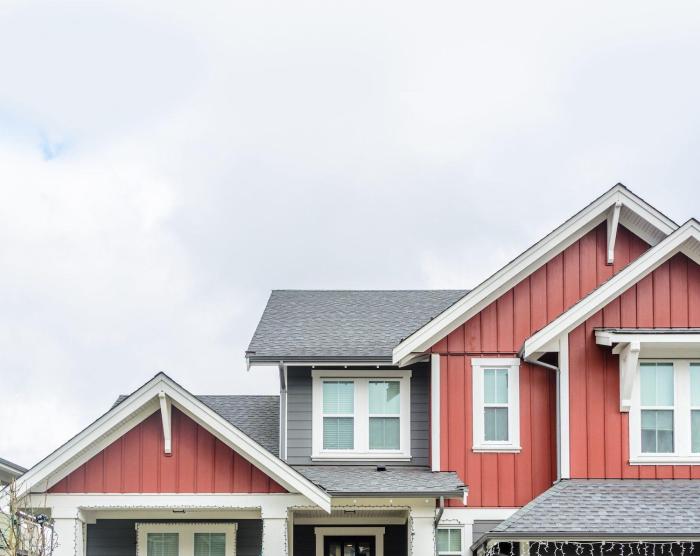
In conclusion, low cost siding options offer a practical and affordable solution for upgrading your home's exterior. Whether you prioritize durability, aesthetics, or energy efficiency, there is a siding material to meet your needs. Explore the variety of options available and take the first step towards enhancing your home's curb appeal today.
Questions Often Asked
What are the most common low-cost siding materials?
Common low-cost siding materials include vinyl, fiber cement, and wood composite.
How does siding material impact energy efficiency?
The type of siding material used can affect the insulation properties of a home, thus impacting energy efficiency.
What are the maintenance requirements for wood composite siding?
Wood composite siding typically requires periodic cleaning and sealing to maintain its appearance and structural integrity.

